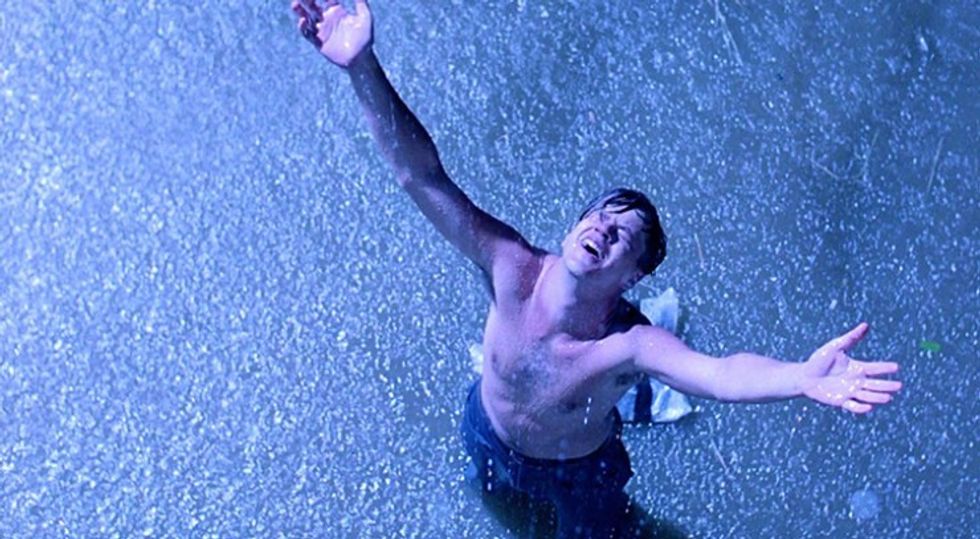
When you’re trying to put together a film you need to sit together with your director of photography and make a shot list. That’s where you’ll pick the different camera angles and movements that will build out your story. So what angles do what? And how will the audience feel if you pick the wrong one?
Today we’re going to narrow our focus to the high angle shot. We’ll look at examples, learn why and when you use it, and leave you with a list of other camera angles that can help you plan your next project.
Let’s jump in.
High angle shot definition
A high-angle shot is a cinematography technique where the camera points down on the subject from above. High-angle shots are used to make the subject or object seem vulnerable, powerless, or weak.
High angle shots in Hitchcock
Alfred Hitchcock was very famous for using these shots in his work. He loved using them to capture people right before they’re about to die or when characters have a sudden revelation. They even became part of Hitchcock’s signature. The website Alfred Hitchcock Films even has a breakdown of shots in Hitchcock movies:
Categories of High Angle Shots in Hitchcock Movies
- DEPRESSION/SHOCK etc.
In the library when little Charlie realizes that her uncle Charlie is a serial killer. - DANGER
The camera shows the dangerous situation the character is in, as it shares the view from a great height. Like when the drunk Roger O. Thornhill (Cary Grant) is looking down in the abyss during his wild car ride (a parallell scene is in Family Plot). Or in Vertigo when Scottie (James Stewart) is looking down the stairs in the bell tower. - SUBJECTIVE CAMERA
The camera shares the character’s view, like in The 39 Steps when Richard Hannay (Robert Donat) is looking down on the street seeing the bad guys who want to kill “Annabella Smith””. - GIVING AN OVERVIEW OF THE SCENE
In The Birds Hitchcock wanted to show the exact topography of Bodega Bay, with the town, the sea, the coast, and the gas station on fire, in one single image (when the birds descend).
Let’s take a look at a few examples from two of Hitch’s most famous films.
First up is this high angle from Psycho.
We get the POV of Norman Bates here as he looks directly down on his victim, This puts us in the shoes of the killer and can make the audience feel uncomfortable. The violence feels more visceral if we imagine ourselves inflicting it.
 Psycho (1960)
Psycho (1960)
Paramount
After that, I want to look at a movie that’s built around high angle shots, Vertigo.
Vertigo is an unusual film where we’re always trying to catch up to Hitchcock’s message. And we’re one step ahead of the characters as well. Still, Hitch puts extra effort into getting us to identify with Jimmy Stewart’s uncomfortableness with heights, mostly shot from a high angle.
We also have to pity him, so to accentuate his helplessness we’re often looking down on him as well. He’s swallowed up within the image, draining everything from the fore and background into his look.
 Vertigo (1958)
Vertigo (1958)
Paramount
Let’s take a look at examples from other films throughout the decades.
High angle shot examples
One of the most famous high angle shots of all time comes from the Shawshank Redemption. While this is meant to make Andy feel vulnerable, it’s actually coming down at him from a god’s eye. We get to see Andy feeling free, but also vulnerable as a prisoner on the outside for the first time. This vulnerability makes us both happy and worried about him. How will he get away?
 Shawshank Redemption (1994)
Shawshank Redemption (1994)
Warner Bros
High angle shots are often used in the climax of movies, like the Harry Potter series. Here we see a character about to fall to his fate.
 Harry Potter and the Deathly Hallows Part 2 (2011)
Harry Potter and the Deathly Hallows Part 2 (2011)
Warner Bros
Harry is overmatched by Voldermort and near his demise…or is he?
Lastly, let’s look at this still of the Avengers taking in the incoming alien hoard. We see shock and awe on their faces. They’re ready to fight and are insignificant to the cause. This gets contrasted later in a low angle when they’re realized how to battle together.
 The Avengers (2012)
The Avengers (2012)
Marvel
What’s next? 50+ camera angles and movements!
Have you ever been overwhelmed at the possibility of every camera angle, framing, and shot type available as a filmmaker?
Us too.
So we provided a cheat sheet with definitions for you! Check them all out, and watch the videos!
Author: Jason Hellerman
This article comes from No Film School and can be read on the original site.
